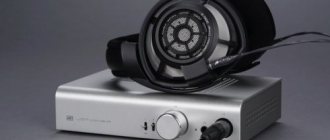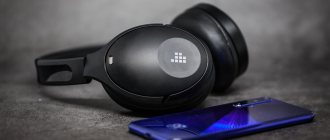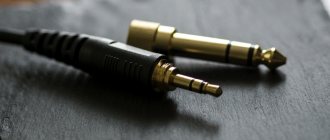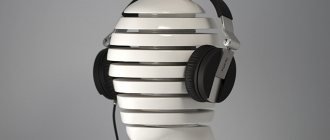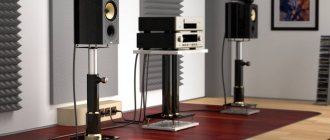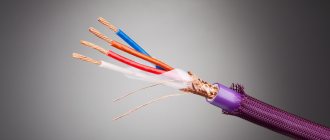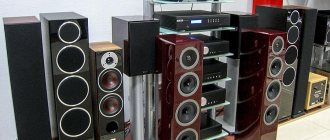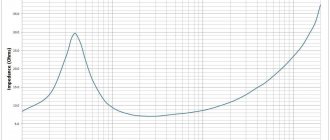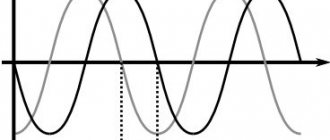4.8 / 5 ( 46 votes)
If a person wants to buy good headphones, relying not only on appearance, but also on sound quality, then he should definitely study the question of what amplitude-frequency response is . This term applies to all audio devices without exception (headphones, amplifiers, speakers, stereo systems, radios, etc.). Decoding and describing the frequency response may seem complicated to some, so we will try to tell everything as simply and easily as possible.
- What is the frequency response of headphones?
- Subtleties of measurements
- Fourier analysis
- Headphone frequency response types
- How to choose headphones by frequency response
- Frequency response for different types of headphones
What is the amplitude-frequency response of headphones?
Amplitude-frequency response (AFC, “frequency response” - English) is the relationship between the amplitude of the output signal and the frequency of its input harmonic signal. Simply put, the frequency response of headphones describes the ability of any type of audio device to reproduce sounds at a certain frequency. Of course, only those sounds that the human ear can detect are taken into account. The hearing of an absolutely healthy person is capable of recognizing sounds oscillating in the range of 20 Hz - 20,000 Hz.
What is frequency response?
Conventionally, the entire audible range is divided into 3 main sections: low, medium and high frequencies.
Frequency response indicators
| Frequencies | Meaning |
| Low | 20 Hz – 300 Hz |
| Average | 300 Hz – 4,000 Hz |
| High | 4,000 Hz – 20,000 Hz |
The ideal situation is when the output from the headphone speakers displays exactly the same signal as was sent to the input. As practice shows, this is not easy to achieve. The cost of such an audio system is quite high.
Subtleties of measurements
Measuring the frequency response of headphones
The frequency response of headphones must be measured using an ultra-sensitive microphone installed in a simulated ear. The prototype should be as similar as possible to the human ear, because the accuracy and correctness of the result depends on this. The vast majority of audio system manufacturers conduct such studies in laboratory conditions, but not all consider it necessary to publish the results.
That is why, before purchasing a specific model, it is recommended to find out as much information as possible on the Internet, including frequency response. If such information is not available on the manufacturer’s official website, you can search in authoritative sources.
Measurements
To measure frequency response, headphones are put on (or inserted) onto a special stand with a measuring microphone. Our laboratory uses HDM1, SFS and IECS stands. A special signal is sent to the headphones and recorded by a microphone. After recording, specialized software calculates the frequency response. ARTA is used to produce the graphs on Personal Audio using a periodic noise test (for headphones). The resulting frequency response in ARTA is exported in text format and then imported into RAA. RAA performs data correction to compensate for the influence of the internal resistance of the amplifier used when testing headphones. Then the final graph is drawn.
Fourier analysis
The analysis method is based on equally well-known Fourier series. The main task is to decompose complex formulas into simpler ones for understanding. Joseph Fourier not only showed, but also scientifically proved that a complex waveform can be represented as a sum of simple waves. Further, simple solutions are summed up and thus one complex problem can be solved.
Fourier analysis
The Fourier transform is a mathematical apparatus designed to decompose signals into sinusoidal oscillations. When spectral analysis of streaming music, attention should be paid to short and individual signals. To analyze such fragments, it is necessary to perform a discrete Fourier transform.
Sony MDR-ZX310
Folding full-size monitor headphones from Sony.
The TOP 8 best monitor headphones are folding headphones from the famous company Sony. The Sony MDR-ZX310 ($20) has powerful bass, like most products in the MDR line. Reliability of design, comfort of use, excellent sound - all this is offered at an inexpensive price. In addition, the model is equipped with a control panel, so it can also be used as a headset.
The widest range: from 10 to 24 thousand Hertz, light weight of 125 grams, two-way cable connection, gold-plated plugs and L-shaped connector, different colors, as well as clear sound - this is all Sony MDR-ZX310.
Headphone frequency response types
Having found out what frequency response is, you need to familiarize yourself with its existing varieties. When determining the sound of headphones, you can see/hear concepts such as “light”, “dark”, “V-shaped”, bland and smooth. If you become familiar with the sound features of each type, it will be easier to purchase the most preferred model.
Light sound
Light sound
What is a “light” frequency response in sound? This concept means weakened bass combined with high accent frequencies. Suitable for playing calm and classical music. The listener will not experience fatigue from excessive bass.
What does the “light” frequency response show? The graph is characterized by unevenness, but the overall average line is a straight line with an increase from low to high frequencies.
Dark sound
Dark sound
What does “dark” frequency response mean? This is the complete opposite of the light sound, the features of which were described a little earlier. Characteristic features - high frequencies are muted, low frequencies, on the contrary, are accentuated.
This type of sound is ideal for playing energetic tracks and for quiet music listening due to the psychoacoustic bass model. At low volumes, such headphones fully display their potential, the sound is more even.
The frequency response graph is characterized by varying unevenness; the overall averaged straight line moves with a strong downward slope from low to high frequencies.
V-shaped sound
V-shaped sound
What is a “V-shaped” frequency response? This is the most common type of headphone amplitude-frequency response, which is characterized by the presence of accentuated bass and high frequencies. This prevalence is due to the powerful rhythm support from percussion and the main bass itself. Note! The V-shaped type of sound frequency response best conveys the rhythm of modern dance compositions.
Some headphones display a V-shaped sound as a smooth line, where there is a uniform rise in the low frequencies between 50 and 200 Hz.
Fresh sound
Bland Sound
A bland sound is the exact opposite of a V-shaped sound. This type is ideal for listening to vocals (acapella). These headphones are also good for playing background sounds.
The main characteristic features are reduced high and low frequencies or an increased range in the mid-frequency region. Headphone models with bland sound are not popular, there is little demand for them. This is due to the “inexpressiveness” of the sound.
Smooth sound
Smooth sound
Smooth sound, when compared with analogues, is considered the most correct. This sound is also called “flat” and is equivalent to having the equalizer turned off.
A characteristic feature is low unevenness, fluctuating in the range between 50 and 7,000 Hz. Despite the fact that this sound is considered the most correct, such headphones are not popular for several reasons:
- external influence (noise on the street, TV sound, etc.) corrects the perception of the evenness of the frequency response;
- The overall volume level affects the perception of the frequency response.
Of course, it is recommended to try listening to music with such headphones at least once, but rather for the sake of variety.
AKG K240S
Comfortable studio over-ear semi-open headphones with increased impedance and precise, detailed sound.
AKG K240S ($75) are inexpensive on-ear, semi-open monitor headphones. The sound is quite smooth, thanks to the semi-open design, there is a wide stage.
By the way, fans of inexpensive models will be interested in the rating of the best budget headphones.
Main characteristics
- Device type: wired headphones
- Type: full size
- Technology: dynamic
- Frequency range: 15 – 25000 Hz
- Impedance: 55 Ohm
- Sensitivity: 101 dB
- Maximum power: 200 mW
- Harmonic distortion: 0.3%
- Weight: 240 g
- Type of acoustic design: semi-open
- Connector: mini jack 3.5 mm
- Gold-plated connectors: yes
- Cable length: 3m
Equipment
- Headphones
- Cable 3 m
- Adapter 6.3 mm
- Case
- Documentation
Video review
- Sound quality. The sound is monitor and that says it all.
- Detachable cable.
- Quality materials and reliability.
- Convenient wire. It is soft and durable at the same time./li>
- Convenience. They sit comfortably on the head.
- Comfort. Your ears may sweat. Ventilation is implemented at a low level.
How to choose headphones based on frequency response?
How to choose headphones based on frequency response?
Having learned what frequency characteristics are called and what types they are divided into, you can familiarize yourself with the rules for choosing headphones based on frequency response characteristics.
- Get acquainted with existing models, choose for yourself several models that are affordable and suitable for certain parameters.
- Decide which type of sound appeals to you the most. For example, for classical, bass, for vocals and others.
- Having decided on the second point, you need to familiarize yourself with the frequency response of each model you like. If preference is given to bass, then the rise should be on the midbass and the lower bass should have a late decline. For connoisseurs of high frequencies, the late decay at the top is ideal. If headphones are necessary for listening to vocals, then it is important to evaluate the average line. There shouldn't be any big ups and downs.
Sennheiser HD 280 Pro
Professional closed headphones for monitoring with linear frequency response.
The tenth place in the TOP of the best monitor headphones deservedly goes to Sennheiser HD 280 Pro ($92) - professional closed headphones for monitoring with a range of frequency response. Smooth, detailed sound and good noise insulation are the main features of this model.
By the way, all fans of the German manufacturer will be interested in reading the rating of the best Sennheiser headphones.
Main characteristics
- Style: full-size, semi-open
- Type: dynamic
- Claimed frequency range: 8 – 25000 Hz
- Resistance: 64 ohms
- Sound pressure level: 113 dB
- Harmonic distortion:
- Input power: 500 mW
- Contact pressure: ≈ 6 N
- Spiral cable length: 3m
- Weight excluding cable: ≈ 285 g
Equipment
- Headphones
- Adapter 3.5 mm to 6.3 mm
- Documentation
Video review
- Sound. The sound is amazing, there is no point in describing anything specifically.
- Comfort and convenience. These headphones sit comfortably on the head, do not squeeze the auricle, fit tightly to the skull, and are adjustable to fit the head size.
- Good sound insulation. The headphones effectively cancel out all extraneous noise.
- Foldable design.
- Fixed cable.
- Set.
Frequency response for different types of headphones
There are several types of headphones that differ not only in design, but also in their operating principle. It is worth familiarizing yourself with the general types of frequency response for different types of headphones in more detail.
Types of frequency response for on-ear, closed and open headphones
In this case, several characteristic types can be observed. Such headphones should be preferred if a person listens to live recordings, where there is a minimum amount of the lowest and, conversely, high frequencies. These headphones are also comfortable to use when listening to vocals.
They are characterized by unevenness in the high-frequency region and a number of dips due to wave interference. On the graphs they look like dips in a narrow frequency range.
Audio Technica ATH-M50X
Full-size closed monitor headphones.
The TOP 11 best monitor headsets are occupied by excellent full-size headphones Audio Technica ATH-M50X ($100). These monitor headphones offer very balanced, detailed sound of excellent quality with deep bass. They fit very comfortably on your head and have soft ear pads, as well as a detachable wire.
They can easily be played via a smartphone, demonstrating a solid volume reserve, fairly powerful bass and a large sound stage. Their sound is smooth, without aggression or excessive pressure of low frequencies.
Main characteristics
- Type – dynamic, closed
- Frequency range: 15 – 28000 Hz
- Impedance: 38 ohms
- Sensitivity: 99 dB/mW
- Maximum power: 1600 mW
- Weight: 285 g
- Connector: mini jack 3.5 mm
- Connector shape: straight
- Cable length: 3m
Equipment
- Headphones
- Adapter 6.3 mm
- Three cables: 1.2 - 3 m (twisted), 3 m (straight), 1.2 m (straight)
- Case
- Documentation
Video review
- Sound. Impeccable sound transmission.
- Landing.
- Good ergonomics.
- Convenience. The headphones have harsh ear pads.
- Demanding on the sound source.
Audio-Technica ATH-R70x
Almost the best studio headphones when you need an open-back model.
Open designs like the ATH-R70x ($395) are generally preferred for long mixing sessions because they are lighter and less tiring than closed models. This model was designed specifically as a reference headphone for mixing.
Main characteristics
- Purpose: monitor
- Construction: overhead, open, full-length Over-Ear
- Connection type: wired
- Connection: Jack (6.35 mm)
- Plug: straight
- Cable connection: double-sided
- Cable type: round
- Detachable: cable
- Impedance: 470 ohms
- Frequency range: 5 – 40000 Hz
- Sensitivity: 99 dB
- Speaker diameter: 45mm
- Emitter type: dynamic
- Case material: metal
- Weight: 210 g without cable
Equipment
- Headphones
- Case
- Documentation
Video review
- Sound. Excellent sound clarity and detail
- Quality of materials.
- Reliability.
- Unique headband design.
- The ear pads are too small.
Microphone
I took the microphone from old stock WM-55A103
I borrowed the switching circuit from comrade Maxim_Sed in his review of Electret microphone + LM386. Measurement of frequency response of promotional headphones.
Sennheiser HD 650
The best monitor headphones in 2022.
TOP 1 in the ranking of the best monitor headphones of 2022 is the Sennheiser HD 650 ($290) - on-ear full-size monitor headphones, the best of the best headphones for audio monitoring. The headphones have an interesting design. The aluminum voice coils used in these headphones are quite lightweight and are capable of providing fast transient response.
So, if you are wondering “Which monitor headphones should I buy?”, then the Sennheiser HD 650 is an excellent option for quality headphones for audio monitoring. They will be good for professional use. In addition, these ears can become a long-awaited purchase for music lovers and connoisseurs of good sound.
Sensitivity
Everyone has encountered a situation where some headphones sound louder than others, even though the level on the player (or smartphone) is set the same. This fact is often associated with the difference in headphone power. But headphones are not an amplifier; this premise is fundamentally wrong.
In fact, how loud the headphones will sound depends on their sensitivity. Traditionally, this parameter lies in the range of 90–120 dB, and for most models available on the market this range is already 95–105 dB. Sensitivity shows how loud the headphones will play, all other things being equal. The higher it is, the higher the maximum volume and the less load on the built-in amplifier of the player or smartphone. I noticed another direct relationship: the cheaper the headphones, the less likely it is that their real (and not indicated in the technical data sheet) sensitivity will be high.
Headphones AKG K 315. Sensitivity - 126 dB, impedance - 32 Ohms, maximum input power - 15 mW.
conclusions
In conclusion, I would like to note that studying the characteristics is an essential, but not decisive, moment when choosing a model. Headphones of different brands with the same technical characteristics differ in volume and quality of the reproduced sound.
When listening, the impression is formed not only by these characteristics, but also by other indicators. No devices have yet been created that could perceive music the way a person can. The factor of subjective perception should be taken into account. This is easy to verify by studying customer reviews, when the same model is rated differently. Some users think the sound is suitable, while others think that the sound is no good.
Therefore, having selected models that are compatible with the sound sources used, they conduct tests, evaluating the sound personally. There is no other way to find sound quality acceptable for a particular user.
Sony MDR-7506 Studio Headphones
One of the best headphones for audio monitoring in 2022.
The Sony MDR series has been around for many years and has a strong studio pedigree, proven through decades of daily use in the recording and broadcast sectors around the world. The current version, the MDR-7506 ($135), is a brilliant combination of comfort, practicality and value—one of the best headphones for monitoring.
Extremely comfortable to wear for long periods of time, the headphones are designed to reveal what's wrong with a recording. On par with competitors that cost twice as much, the sound is punchy and clear across the entire spectrum (with a moderate boost in the upper mids).
Let's recap
1) The frequency response graph is not an absolute and universal means of determining sound quality.
Too many errors in measurements. 2) Even headphones with an ideal frequency response graph will not necessarily suit you personally due to the structural features of your particular ears and/or musical tastes. 3) Brands are reluctant to share the frequency response of their headphones; Bluedio is one of the few honest manufacturers that reveals all its cards to the buyer. 4) The frequency response graphs of Bluedio headphones are comparable to those of more expensive headphones and effortlessly “make” inexpensive “ears” of famous brands. 5) If you buy Bluedio, I recommend the flagship model Vinyl Premium and only from the official representative of Bluedio in Russia - the online retailer UMmall.ru. Fortunately, headphones are sold at UMmall at fair “Chinese” prices - on all Ali Express the price tags are the same as on UMmall. Good music to you, friends!
